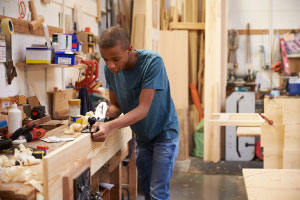Online courses directory (272)
Design your own world. Are you ready? This MOOC is a journey into contemporary design through 101 exercises. Learn by doing and transform your everyday life into 101 projects.
How can architecture help people in times of urgent need caused by natural disasters? In this course, we will design resilient schools that could serve as community centers and shelters for the victims of the devastating typhoon Haiyan in the Philippines.
This course is an exciting look at the advanced study of rigid bodies in motion (dynamics) as applied to engineering systems and structures.
We live on the surface of a dynamic and yet paradoxically stable planet that experiences a remarkable range of energetic phenomena, from waves and currents in the ocean to wind and thunderstorms in the atmosphere. This course traces how the remarkable concept called energy is the natural way of describing, understanding and unifying these diverse phenomena. The course traces the cascade of energy from sunlight to its final destination in a thermal form, considering differential surface heating, the role of convection and buoyancy and the formation of the Earth’s circulation system, and the links to the ocean circulation system. We consider the curvature and rotation of the Earth as key constraints on a system driven by sunlight and energy transformations.
Before your course starts, try the new edX Demo where you can explore the fun, interactive learning environment and virtual labs. Learn more.
How much time will the course take?
Obviously the answer will depend on your background and motivation to master the course material. Each week will consist of 5 or 6 segments that will each take 5 to 10 minutes to watch or listen to once. There will be some exploratory questions for each lesson and a confirmation quiz for each week. There will be one exploratory activity for each week. The average commitment will be 2-3 hours per week with perhaps 20 hours required for the whole course.
What background does the course assume?
We’ll ask you to pull out a calculator from time to time (but not all the time!) simply as this will help you really master the key ideas. The key thing is to have a curiosity and interest in what makes our planet tick!
What kind of learning activities will the course involve?
The activities are designed to use basic household objects, and our own senses, to engage with observations of the world, and to think about what these mean and lead to. We’ll get you to sense how cold or warm different objects get when left in the sun, and to observe how energy explains things we see and hear.
What difference will the course make to my life?
The course has the conviction that it is hard to care for or value things that we don’t appreciate or have never considered. Although harsh in certain places and times, the Earth’s surface is remarkably habitable. Many forms of life can make their way in many kinds of terrain and climate. What produces these conditions? How are they maintained? We will seek to answer those questions in rudimentary form at least.
What conversations will the course help to perform?
Courses often imagine a context in which the course material is discussed, and this one is no different. It imagines a setting with family or friends where you might have just learned of a news event involving a storm like a hurricane or thunderstorm, or where a community might have experienced a flood or a drought, or merely unusual weather. You might have heard of El Nino or climate change in the news. This course will give you a background to better engage in a conversation about these great matters, and offer a better sense of the complexity, challenge and wonder connected to living on the surface of such an energetic planet.
Principles of Electric Circuits (20220214x) is one of the kernel courses in the broad EECS subjects. Almost all the required courses in EECS are based on the concepts learned in this course, so it’s the gateway to a qualified EECS engineer.
The main content of this course contains linear and nonlinear resistive circuits, time domain analysis of the dynamic circuits, and the steady state analysis of the dynamic circuits with sinusoidal excitations. Important concepts, e.g. filters, resonance, quiescent point, etc., cutting-edge elements, e.g. MOSFETs and Op Amps, etc., systematic analyzing tools, e.g. node method and phasor method, etc., and real-world engineering applications, e.g. square wave generator and pulse power supply for railgun, etc., will be discussed in depth.
In order to facilitate the learning for students with middle school level, we prepare the necessary knowledge for calculus and linear algebra in week 0. With your effort, we can show you the fantastic view of electricity.
电路原理课程是电类各专业最重要的一门学科基础课,后续各专业基础课和专业课都建立在这门课程的知识体系之上,因此是电类专业本科生的“看家 课”之一。电路原理课程的主要内容包括:线性电阻电路分析、非线性电阻电路分析、动态电路的时域分析和正弦激励下动态电路的稳态分析4大部分。清华大学电 路原理课程的教学包括电路分析基本方法、当代电路元器件、电路原理的实际工程应用等,为学生提供了扎实的基础和丰富的应用。
为方便至只有中学知识的学生学习,电路原理MOOC专门利用第0周准备必要的微积分、线性代数和大学物理电学的基础。我们有信心:你能领悟电世界的奇妙。
Robots are rapidly evolving from factory workhorses, which are physically bound to their work-cells, to increasingly complex machines capable of performing challenging tasks in our daily environment. The objective of this course is to provide the basic concepts and algorithms required to develop mobile robots that act autonomously in complex environments. The main emphasis is put on mobile robot locomotion and kinematics, environment perception, probabilistic map based localization and mapping, and motion planning. The lectures and exercises of this course introduce several types of robots such as wheeled robots, legged robots and drones.
This lecture closely follows the textbook Introduction to Autonomous Mobile Robots by Roland Siegwart, Illah Nourbakhsh, Davide Scaramuzza, The MIT Press, second edition 2011.
Ce cours définit les notions de base des circuits électriques composés des trois éléments passifs (résistance, inductance et condensateur), linéaires et des sources de tension et de courant.
On traite ces circuits avec les lois élémentaires de l'électricité puis on développe une série de méthodes de combinaisons des éléments et de transformations du circuit qui mènent à leur simplification et permettent une analyse aisée des courants, tensions et puissances présents. Quelques circuits particuliers classiques sont présentés.
Toutes ces méthodes sont premièrement développées en régime continu puis elles sont généralisées au régime alternatif, faisant intervenir le calcul complexe. L'importance du régime alternatif réside dans le fait qu'il est omniprésent au niveau de la distribution électrique domestique et industrielle.
This course is presented in French.
هو مساق للمهتمين في التعرف على أدوات الاستشعار الحديثة التي تستعين بتقانة النانو (وهي التقانة التي تبحث في المجال بين واحد إلى مئة نانوميتر، أي في أجزاء من المليار من المتر) لفرز ومراقبة الأحداث المختلفة في حياتنا الشخصية أو العملية. في أطار المساق، سنكتشف معا عالم النانو المذهل الذي يتعامل مع الوحدات الأساسية في بناء المادة. وبهذا سوف نمهد الطريق لتطبيقات إبداعية لانهائية تطبق في كل جزء من حياتنا اليومية، بدءا من تشخيصات وعلاجات (في الجسم الحي أو خارجه) للأمراض، وثم نستمر في تقانة مراقبة جودة المنتوجات وما يختص بالبيئة، وننهي في تقانة مراقبة القضايا الأمنية. سنتعلم في هذا السعي كيف نصَنع هذه الأدوات الجديدة، وكيف نميزها، وكيف نتحكم بها، وكيف ندمجها في التطبيقات المختلفة.
Concepts in Nanotechnology is a six-week introduction to nanotechnology. The course is designed at a pre-college level, with no college level chemistry, math, or physics experience required. You will learn what nanotechnology is and what it means for something to be a nanomaterial. You will also learn about the applications and commercial products that use nanotechnology. This is an exciting opportunity to delve into the nano-world. Prerequisites: The course is taught entirely in English and aimed at a U.S. high school level. You need to be familiar with the basic concepts of chemistry, such as the theory of atoms and the periodic table of elements. Basic algebra skills, such as how to deal with equations containing variables, fractions, and exponents is necessary. No prerequisite knowledge in nanotechnology, materials science, or physics is required.
16.885J offers a holistic view of the aircraft as a system, covering: basic systems engineering; cost and weight estimation; basic aircraft performance; safety and reliability; lifecycle topics; aircraft subsystems; risk analysis and management; and system realization. Small student teams retrospectively analyze an existing aircraft covering: key design drivers and decisions; aircraft attributes and subsystems; and operational experience. Oral and written versions of the case study are delivered. For the Fall 2005 term, the class focuses on a systems engineering analysis of the Space Shuttle. It offers study of both design and operations of the shuttle, with frequent lectures by outside experts. Students choose specific shuttle systems for detailed analysis and develop new subsystem designs using state of the art technology.
This is the second undergraduate architecture design studio, which introduces design logic and skills that enable design thinking, representation, and development. Through the lens of nano-scale machines, technologies, and phenomena, students are asked to explore techniques for describing form, space, and architecture. Exercises encourage various connotations of the "machine" and challenge students to translate conceptual strategies into more integrated design propositions through both digital and analog means.
Carpentry is a highly skilled trade and the work carpenters carry out is essential during the construction phase of items as varied as residential and commercial buildings, ships, timber bridges, concrete formwork etc. The main work performed by a carpenter during the construction phase is the cutting, shaping and installation of building materials. In this free online course the learner will be introduced to skills that are essential during the construction phase of any project such as reading plans and elevations so that construction designs can be understood, how to build floor systems for residential and commercial properties, how to build and construct wall and ceiling framing systems, and the methodologies of roof framing. This course will be of great interest to all construction professionals who would like to learn more about the use of carpentry skills as part of the construction process, and to all learners who are interested in carpentry and construction as a career.
There is a constant demand for carpenters in the construction trade. Today, expertise in working with various types of building materials is an indispensable requirement of a carpenter's job. Formwork and joinery are two such areas where skilled carpenters would find themselves working with diverse materials. Formwork involves constructing the forms into which concrete is poured, whereas joinery comprises of working with the wooden parts of a building, such as window frames and doors. Both jobs require further knowledge of working with wood, concrete, and other building materials such as steel reinforcement bars. This free online course will introduce the learner to the basic practices involved in formwork and joinery. The course explains the general types of concrete, concrete mixing information, and the test carried out to measure the workability of fresh concrete. The course also outlines the key components and terms associated with windows, exterior doors, and stairways used in residential construction. This course will be of great interest to all construction professionals who would like to learn more about the carpentry skills involved in finishing and closing off a structure. It will also be of interest to all learners who want to further develop their career in carpentry and the construction trade.<br />
An age-old and highly skilled trade, carpentry has evolved to incorporate improved building materials and construction methods. Modern-day carpenters find themselves working on a variety of projects that span both the residential and commercial sectors. A sound knowledge of the tools, materials, and building methods is therefore an indispensable requirement of the job. This free online Diploma course introduces the learner to the current practices in the trade. The first section of the course traces the history of the trade from the primitive to the modern times. It focuses on the various building materials, fasteners, adhesives, and tools used by carpenters in the construction industry. A brief explanation of the safety guidelines and procedures is also covered in this section. The essential work performed by carpenters during the construction phase of any project comprises the next section of this course. Here, the learner is introduced to reading plans and elevations, and the methodologies for constructing floor systems, wall and roof framing. The final section of the course deals with the work involved in closing off a structure. From introduction to concrete forms used in construction to the installation of windows, exterior doors and stairs, this section provides a brief overview of these topics. This free Diploma course will be of great interest to professionals who want to learn about contemporary procedures and practices in carpentry. It will also be of interest to all learners who want to further develop their career in carpentry and the construction trade. <br />
Electricity lights up our streets and buildings, and enables us to use and enjoy the many electronic devices that make our lives more comfortable. Skilled electricians and engineers work behind the scenes to ensure that we receive a continuous supply of electric power. In order to do this, they need to have a thorough understanding of the basic concepts and practices of the electrical trade that enables them to install and maintain functional electrical systems. <br /><br />In ALISON's free online diploma course, the first section introduces you to the electrical trade. Topics on electrical safety, electrical circuits, and electrical theory are discussed in this section. The next section of the course focuses on what constitutes an electrical wiring system. This section explains the installation procedures and storage techniques for electrical wiring components such as device boxes, raceways and fittings, conductors and cables. The final section of the course covers the electrical drawings and test equipment used in the trade. Some of this test equipment includes ammeters, galvanometers, voltmeters, multi-meters. <br /><br />ALISON's free Diploma course will be of great interest to professionals in the areas of construction and electrical engineering. Learners who want to gain a practical knowledge and understanding of the electrical trade would also benefit from the concepts explained in this course.<br />
This course will explore the mutual influences of ideas of nature, theories of city design and planning, and practices of urban design, construction, and management. We will investigate how natural processes shape urban landscapes (from the scale of street corner to region) and how to intervene strategically in those processes in order to achieve certain goals. We will examine cases of cities that adapted successfully to natural processes and those that did not. Students will then have the opportunity to research a case of their choice and to present their findings for discussion. The subject may be historical or an an example of contemporary theory and practice. Additional information is also available at Professor Spirn's class website.
*Note - This is an Archived course*
This is a past/archived course. At this time, you can only explore this course in a self-paced fashion. Certain features of this course may not be active, but many people enjoy watching the videos and working with the materials. Make sure to check for reruns of this course.
Composites are used in many industries today to enable high-performance products at economic advantage. These industries range from space to sports and include manufactured products for aircraft, transportation, energy, construction, sports, marine, and medical use. There are many material, economic and aesthetic advantages to using composites, but a solid knowledge of the physical properties, including the mechanics, tooling, design, inspection & repair, and manufacturing options is required for working in this medium as they are intrinsically linked.
This course provides an introduction to the fundamentals of composite materials for high performance structures from the point of view of Aerospace engineering design, manufacturing, and repair. It is designed to address critical areas of composite technologies that focus on materials, manufacturing, mechanics, design, inspection, and repair. In this course students will learn how composite materials achieve properties of strength, weight ratios and durability that surpass aluminum in aircraft design. For these high performance applications engineers typically rely on laminated structures, which are built up from many varying layers of ply-materials. Using this process the mechanical properties of the composite part can be tailored to specific applications resulting in significant weight and cost savings. Tailoring specific properties and designing innovative laminate structures highlights the multidisciplinary nature of this industry and how it touches the expertise of many disciplines including engineers, mechanics, and inspection specialists.
After successfully completing this course, students will be able to identify the unique characteristics of composites and understand how advanced composite structures are designed, manufactured and maintained.
Who Can Take This Course?
Unfortunately, learners from Iran, Sudan, Cuba and the Crimea region of Ukraine will not be able to register for this course at the present time. While edX has received a license from the U.S. Office of Foreign Assets Control (OFAC) to offer courses to learners from Iran, Sudan and Cuba, our license does not cover this course. Separately, EdX has applied for a license to offer courses to learners in the Crimea region of Ukraine, but we are awaiting a determination from OFAC on that application. We are deeply sorry the U.S. government has determined that we have to block these learners, and we are working diligently to rectify this situation as soon as possible.
In recent years, flying robots such as miniature helicopters or quadrotors have received a large gain in popularity. Potential applications range from aerial filming over remote visual inspection of industrial sites to automatic 3D reconstruction of buildings. Navigating a quadrotor manually requires a skilled pilot and constant concentration. Therefore, there is a strong scientific interest to develop solutions that enable quadrotors to fly autonomously and without constant human supervision. This is a challenging research problem because the payload of a quadrotor is uttermost constrained and so both the quality of the onboard sensors and the available computing power is strongly limited.
In this course, we will introduce the basic concepts for autonomous navigation for quadrotors. The following topics will be covered:
- 3D geometry,
- probabilistic state estimation,
- visual odometry, SLAM, 3D mapping,
- linear control.
In particular, you will learn how to infer the position of the quadrotor from its sensor readings and how to navigate it along a trajectory.
The course consists of a series of weekly lecture videos that we be interleaved by interactive quizzes and hands-on programming tasks. For the flight experiments, we provide a browser-based quadrotor simulator which requires the students to write small code snippets in Python.
This course is intended for undergraduate and graduate students in computer science, electrical engineering or mechanical engineering. This course has been offered by TUM for the first time in summer term 2014 on EdX with more than 20.000 registered students of which 1400 passed examination. The MOOC is based on the previous TUM lecture “Visual Navigation for Flying Robots” which received the TUM TeachInf best lecture award in 2012 and 2013.
FAQ
Do I need to buy a textbook?
No, all required materials will be provided within the courseware. However, if you are interested, we recommend the following additional materials:
- This course is based on the TUM lecture Visual Navigation for Flying Robots. The course website contains lecture videos (from last year), additional exercises and the full syllabus: http://vision.in.tum.de/teaching/ss2013/visnav2013
- Probabilistic Robotics. Sebastian Thrun, Wolfram Burgard and Dieter Fox. MIT Press, 2005.
- Computer Vision: Algorithms and Applications. Richard Szeliski. Springer, 2010.
Do I need to build/own a quadrotor?
No, we provide a web-based quadrotor simulator that will allow you to test your solutions in simulation. However, we took special care that the code you will be writing will be compatible with a real Parrot Ardrone quadrotor. So if you happen to have a Parrot Ardrone quadrotor, we encourage you to try out your solutions for real.
Trusted paper writing service WriteMyPaper.Today will write the papers of any difficulty.




















